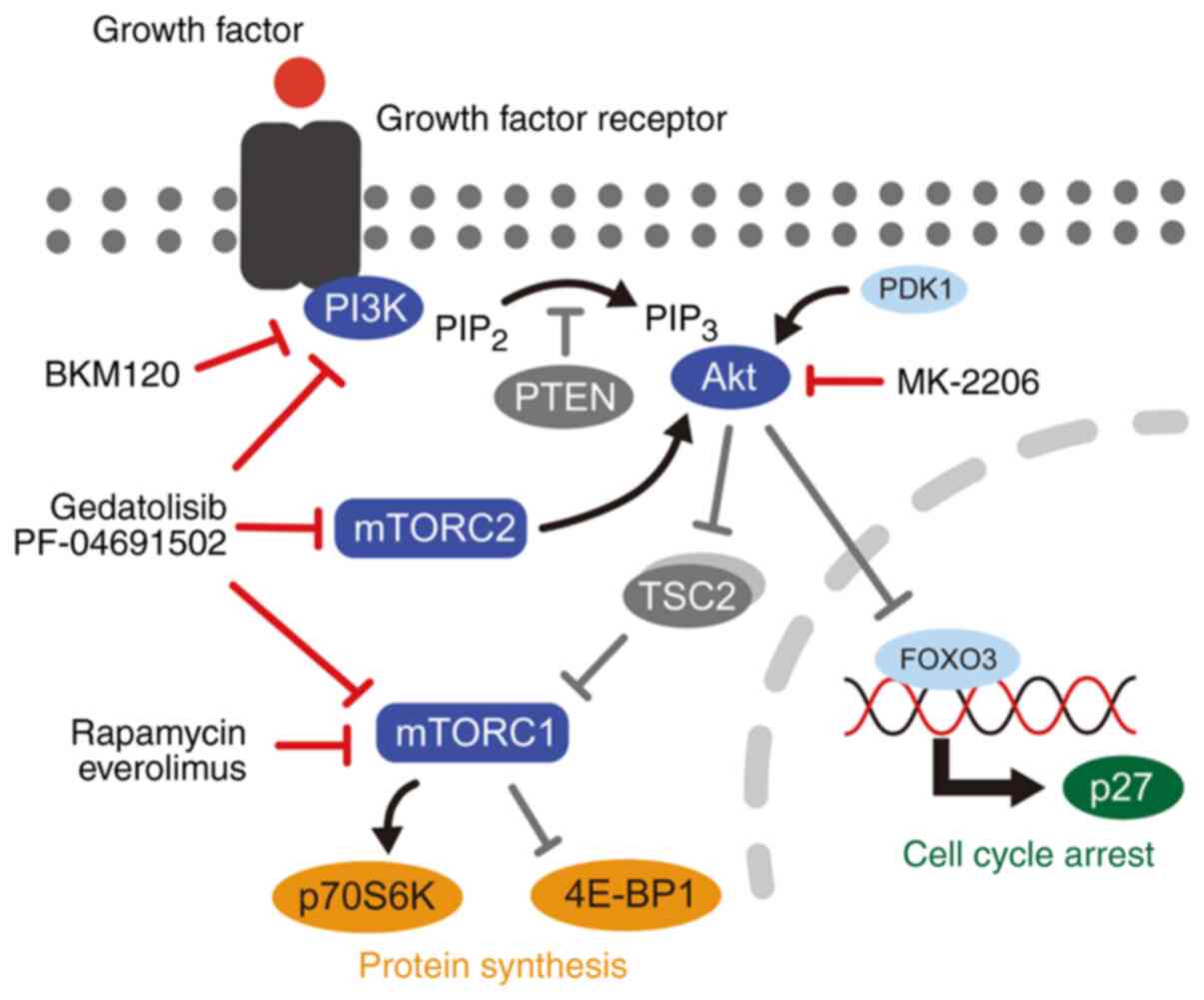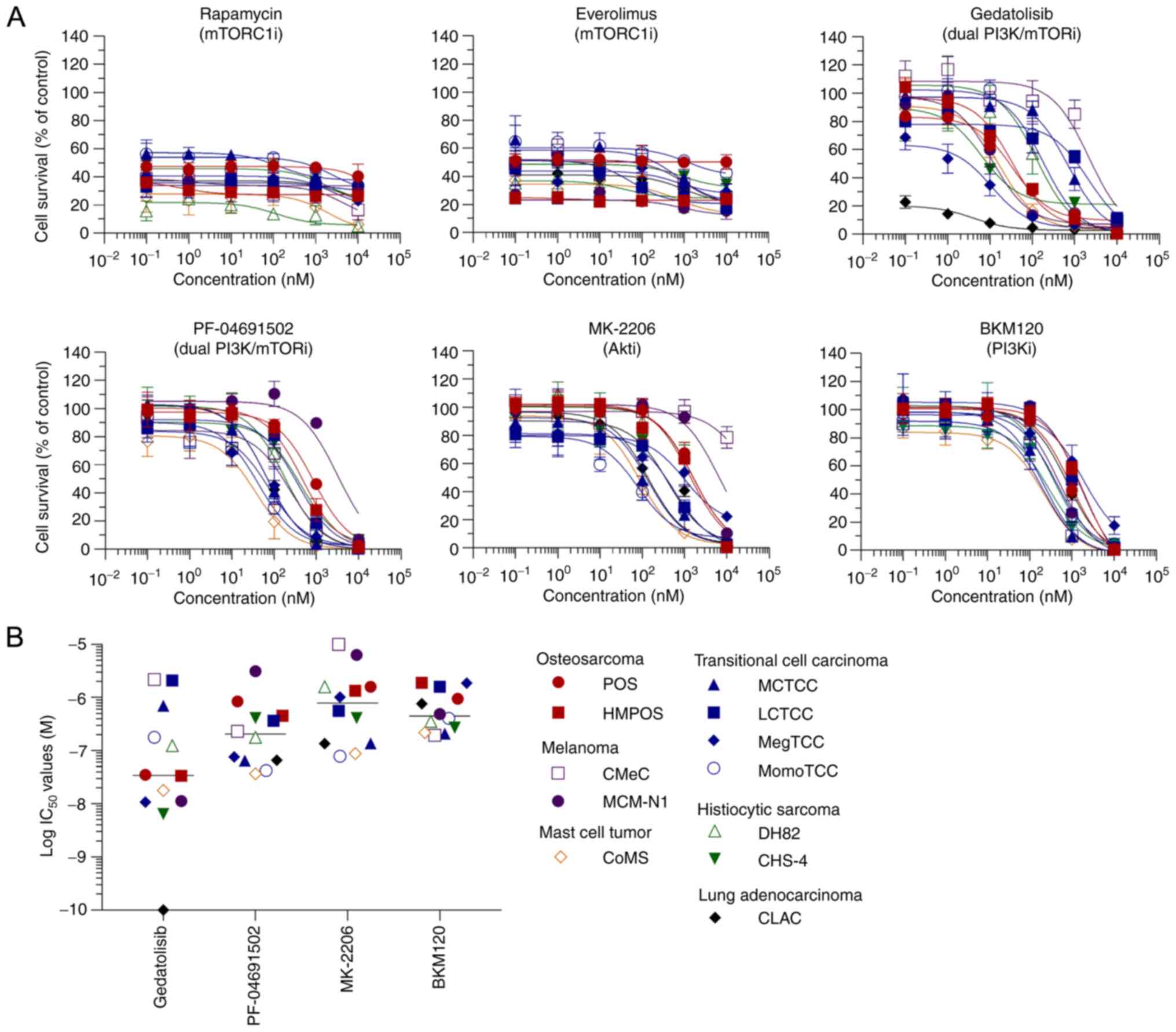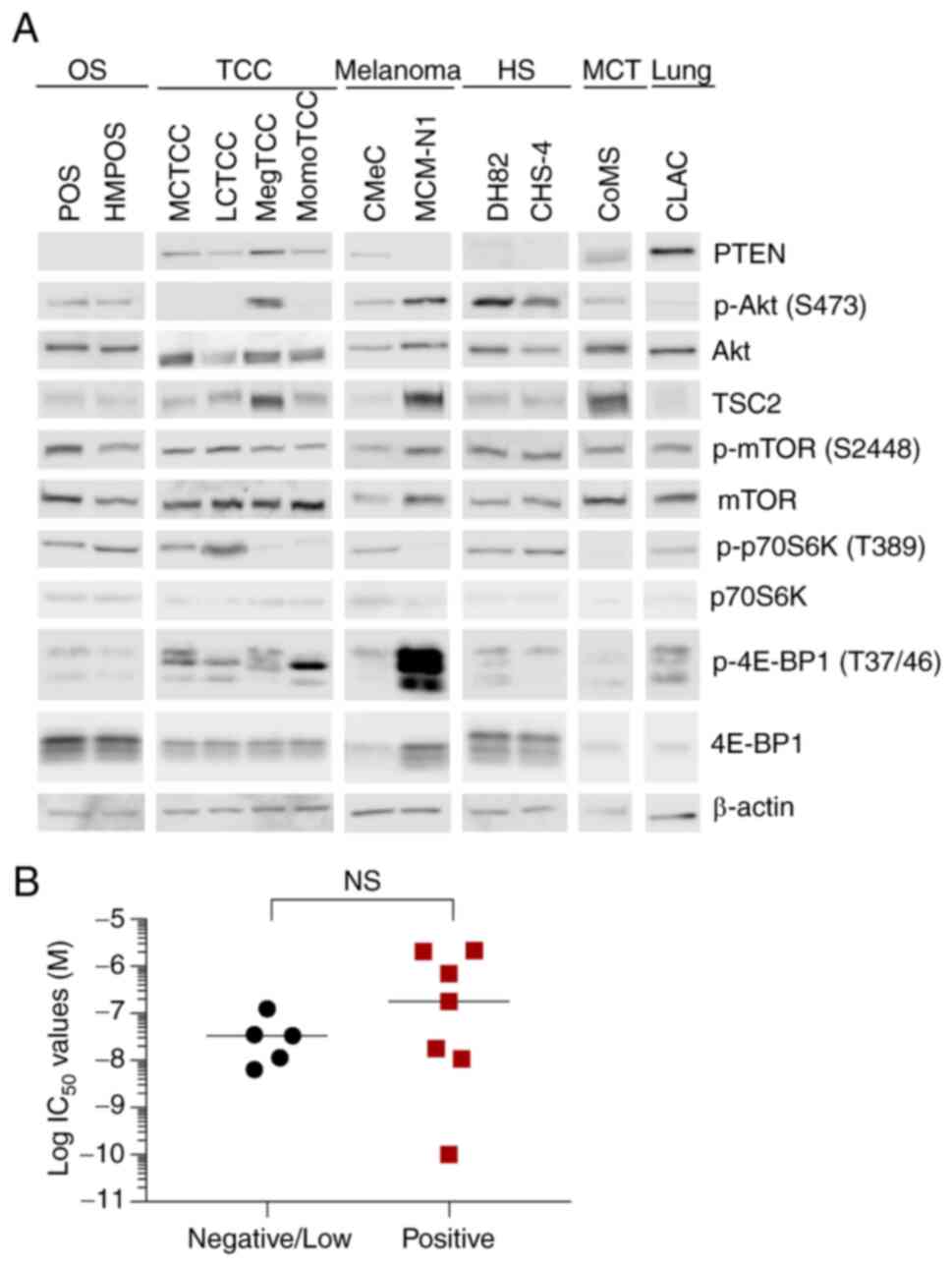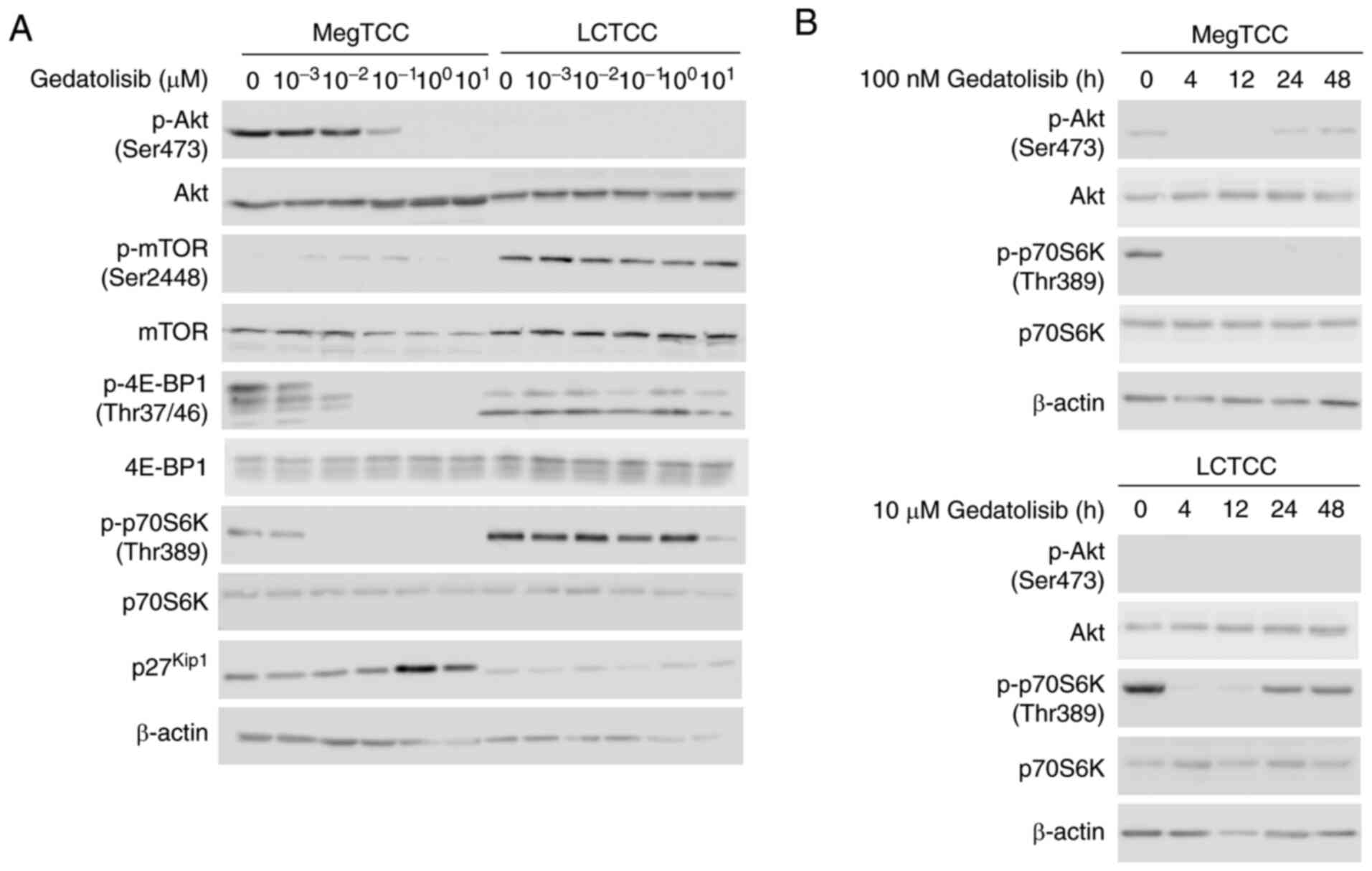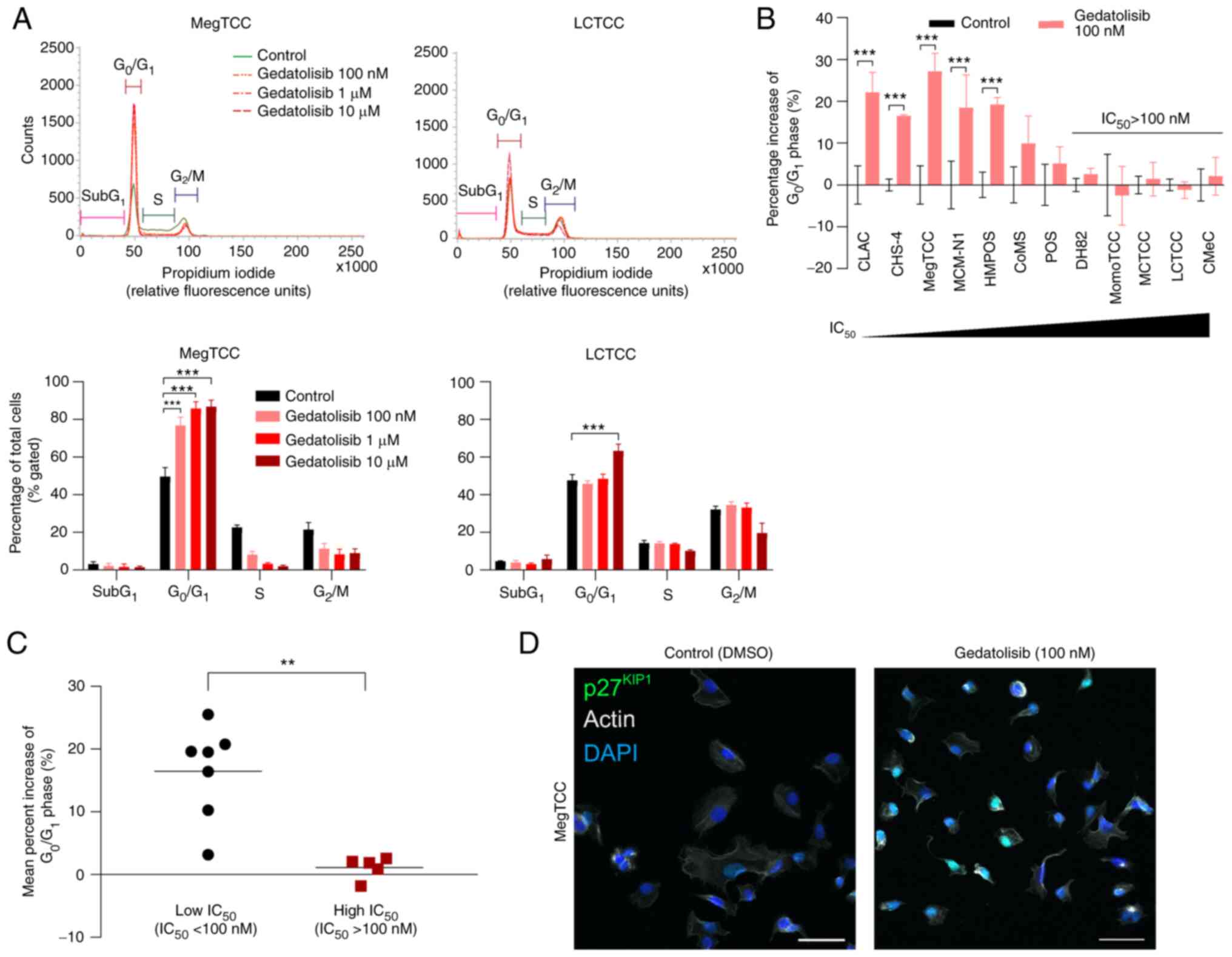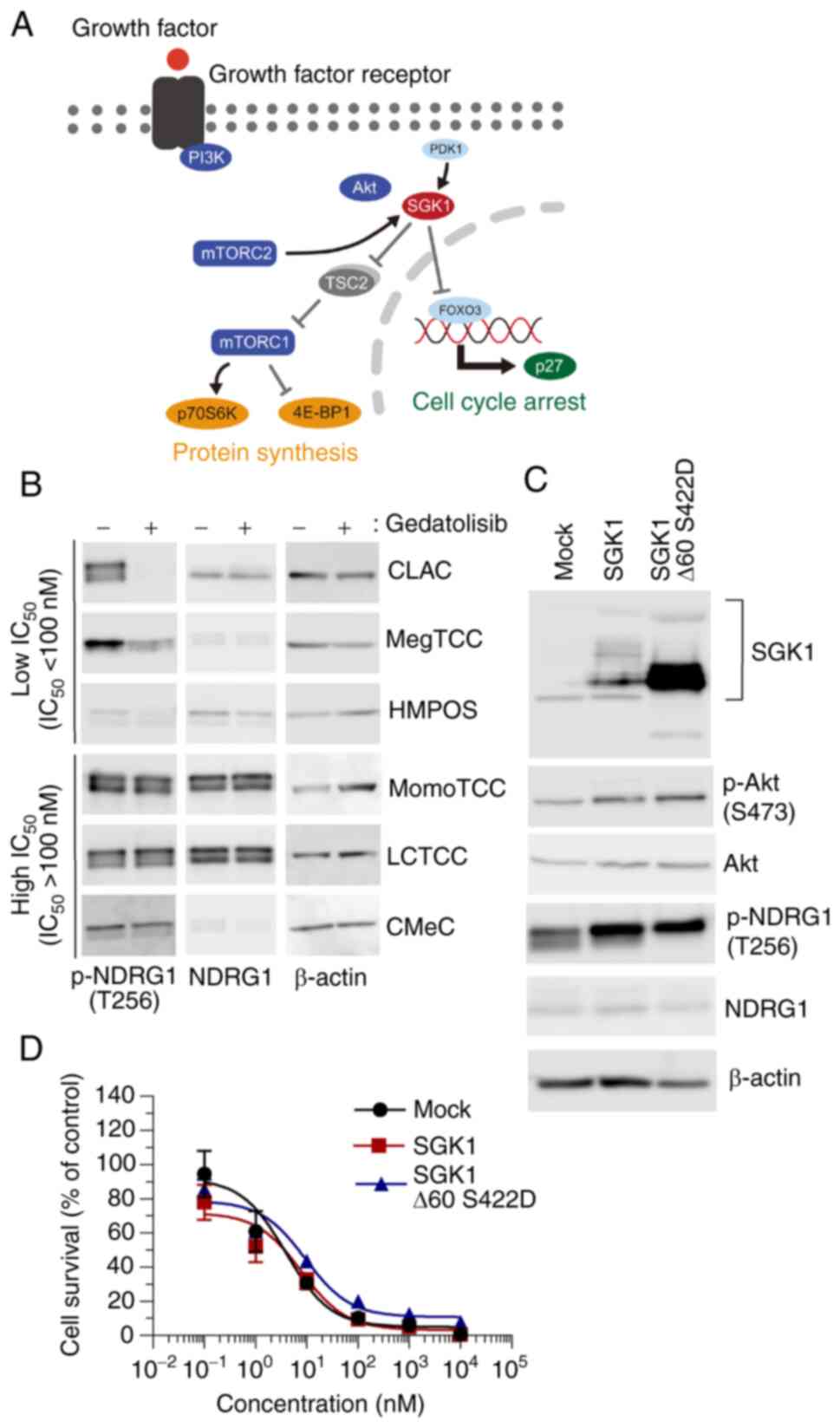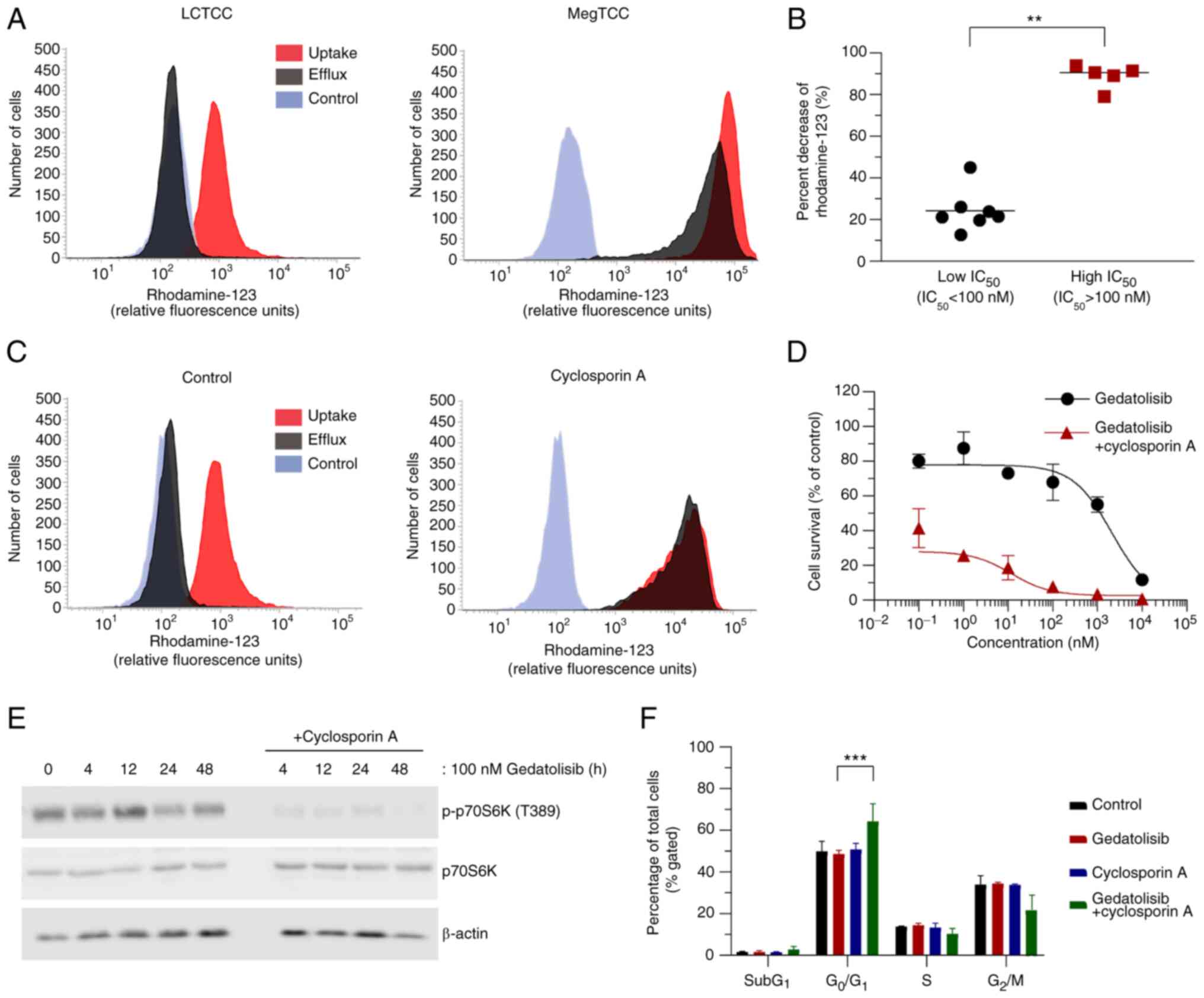Antitumor activity of the dual PI3K/mTOR inhibitor gedatolisib and the involvement of ABCB1 in gedatolisib resistance in canine tumor cells
- Authors:
- Published online on: January 27, 2022 https://doi.org/10.3892/or.2022.8272
- Article Number: 61
-
Copyright: © Murase et al. This is an open access article distributed under the terms of Creative Commons Attribution License.
Abstract
Introduction
The phosphatidylinositol 3-kinase/mammalian target of rapamycin (PI3K/mTOR) signaling pathway plays an important role in cellular proliferation, growth, and survival by integrating signals from growth factors, cytokines, and other environmental sources (1,2). PI3K/mTOR inhibitors are therapeutic agents developed for various types of human tumors (3). These inhibitors include PI3K inhibitors, Akt inhibitors, mTOR complex 1 (mTORC1) inhibitors, and dual PI3K/mTOR inhibitors that inhibit PI3K catalytic isoforms, mTORC1, and mTOR complex 2 (mTORC2). Dual PI3K/mTOR inhibitors are more potent because they suppress the feedback re-activation that limits the efficacy of mTORC1 inhibitors (4,5).
Studies of dual PI3K/mTOR inhibitors indicate that several molecular mechanisms affect antitumor activity. In the PI3K/mTOR signaling pathway, mutations in the PIK3CA gene, which encodes the PI3Kα isoform, and the loss of phosphatase and tensin homolog (PTEN) increase sensitivity to dual PI3K/mTOR inhibitors (6). In contrast, various biological processes, including compensatory signaling pathways (7,8), the epithelial-mesenchymal transition (9), and drug efflux with ATP binding cassette transporters (10) mediate cellular resistance to dual PI3K/mTOR inhibitors. Despite these discoveries, strategies to overcome resistance mechanisms and develop biomarkers associated with clinical outcomes are not established. Therefore, the identification of the molecular determinants that affect the antitumor activity of these inhibitors is necessary to maximize the clinical outcomes for dual PI3K/mTOR inhibitor treatments (3).
The PI3K/mTOR signaling pathway is activated in specific canine tumors, including hemangiosarcoma (11,12), mammary carcinoma (12,13), glioma (12), lymphoma (12), mast cell tumor (12,14), osteosarcoma (15,16), and melanoma (17–19). Dual PI3K/mTOR inhibitors decreased cell viability and induced apoptosis, primarily in melanoma and hemangiosarcoma in vitro (19,20). However, the molecular mechanisms involved in the cellular resistance are not clear in any canine tumor.
The aim of the present study was to investigate the in vitro antitumor activity of gedatolisib, a dual PI3K/mTOR inhibitor, against various canine tumors, and to explore the molecular determinants involved in the cellular sensitivity to gedatolisib. The antitumor activity of gedatolisib on cell viability, protein phosphorylation, and cell cycle distribution was assessed using 12 canine tumor cell lines from six types of tumor. In addition, the involvement of serum-and-glucocorticoid-regulated kinase 1 (SGK1), PIK3CA, and ATP-binding cassette, subfamily B, member 1 (ABCB1) was investigated in gedatolisib resistance.
Materials and methods
Cell lines and culture
Two canine osteosarcoma cell lines (POS and HMPOS) (21,22), four canine urinary bladder transitional cell carcinoma (TCC; canine equivalent of muscle-invading bladder cancer in humans) cell lines [MCTCC, LCTCC, MegTCC, and MomoTCC, which was established at our laboratory (Laboratory of Veterinary Surgery, Department of Clinical Sciences, Graduate School of Veterinary Medicine, Sapporo, Japan) and erroneously named as MonoTCC in a previous study] (23,24), two canine malignant melanoma cell lines [CMeC, which was provided by the University of Tokyo (Tokyo, Japan) and MCM-N1, which was purchased by DS Pharma Biochemical Co., Ltd.] (25,26), two canine histiocytic sarcoma cell lines (DH82, which was purchased by DS Pharma Biochemical Co., Ltd. and CHS-4, which was provided by the University of Tokyo) (27,28), a canine mast cell tumor cell line (CoMS, which was established at our laboratory) (29), a canine lung adenocarcinoma cell line [CLAC, which was provided by Azabu University, (Sagamihara, Japan)] (30), and a human embryonic kidney cell line (293T, which was provided by Laboratory of Comparative Pathology, Department of Clinical Sciences, Faculty of Veterinary Medicine, Hokkaido University) were used in the present study. Each cell line was maintained in Dulbecco's modified Eagle's medium (DMEM; Thermo Fisher Scientific, Inc.) or RPMI-1640 medium (Thermo Fisher Scientific, Inc.) supplemented with 10% fetal bovine serum (FBS; Nichirei Biosciences, Inc.), 100 IU/ml penicillin G (Wako Pure Chemical Industries, Ltd.), and 100 µg/ml streptomycin (Wako Pure Chemical Industries, Ltd.) at 37°C and 5% CO2.
Inhibitors
Two mTORC1 inhibitors, rapamycin and everolimus, were purchased from Adipogen Life Sciences and AdooQ Bioscience, respectively. Two dual PI3K/mTOR inhibitors (gedatolisib and PF-04691502), one Akt inhibitor (MK-2206), and one PI3K inhibitor (BKM120) were purchased from AdooQ Bioscience. ABCB1 inhibitors, cyclosporin A and tariquidar, were purchased from Wako Pure Chemical Industries, Ltd. and MedChemExpress, respectively. A receptor tyrosine kinase inhibitor, toceranib, was purchased from Toronto Research Chemicals. All inhibitors were dissolved in dimethyl sulfoxide (DMSO) and stored in aliquots at −30°C.
Cell viability assay
Cells were seeded at densities of 0.3–2×103 cells/well in 96-well plates (the density of the cells was based on the growth rate of each cell line), allowed to attach overnight, and treated with 0.1% DMSO (control) or various concentrations (0.1 nM-10 µM) of each inhibitor for 96 h. The cell viability was determined using a WST-1 assay kit (Takara Bio, Inc.). The final concentration of premix WST-1 was 9% (10 µl premix WST-1/100 µl culture medium), and the incubation period was 4 h at 37°C with 5% CO2. The absorbance was measured at 450 and 620 nm using a Multiskan FC microplate spectrophotometer (Thermo Fisher Scientific, Inc.).
Immunoblotting
Cell lysis, sodium dodecyl sulfate-polyacrylamide gel electrophoresis, and immunoblotting were performed as previously described with minor modifications (31,32). The protein concentrations of each lysate were quantified using a Protein Quantification kit (Takara Bio, Inc.). The primary antibodies and secondary antibody used in the present study are listed in Table SI. The proteins were visualized using the Western BLoT Ultra-Sensitive HRP Substrate (Takara Bio, Inc.) and detected using an ImageQuant LAS-4000 mini system (GE Healthcare; Cytiva).
To prepare the cell lysate, 6×104 cells were seeded in 6 cm dishes and cultured for 48 h at 37°C and 5% CO2. For evaluation of the dose-dependent suppression of gedatolisib, the cells were treated with 0.1% DMSO or various concentrations (0.1 nM-10 µM) of gedatolisib for 24 h. For evaluation of the time-dependent suppression of gedatolisib, the cells were treated with 0.1% DMSO or gedatolisib (100 nM or 10 µM) for 0, 4, 8, 24 and 48 h. For immunoblotting analysis of p-NDRG1 (Thr346), the cells were treated with 0.1% DMSO or 100 nM gedatolisib for 4 h.
Cell cycle analysis
Cells were seeded at 1–4×105 cells/10-cm dish and incubated for 72 h at 37°C and 5% CO2. The cells were then treated with DMSO or gedatolisib (0.1, 1, or 10 µM) for 24 h, collected using 0.25% trypsin-ethylenediaminetetraacetic acid (EDTA) in phosphate-buffered saline (PBS), and fixed with 70% ethanol overnight at −30°C. The fixed cells were treated with RNase A (10 µg/ml in PBS; EMD Millipore) for 30 min at 37°C and stained with 50 µg/ml propidium iodide (PI) in PBS for 20 min at 25°C. The DNA content of the cells was measured using a FACSVerse system (BD Biosciences) equipped with a 488-nm argon laser and 527/32 and 700/54 nm bandpass filters. The percentage of cells at each stage of the cell cycle was calculated by manually gating the histograms. All data were analyzed using the FACSuite software 1.0 (BD Biosciences).
Immunocytochemistry
Immunocytochemistry was performed as previously described with minor modifications (33). Cells (0.2×105) were cultured in an 8-well culture slide (Iwaki®) with 400 µl of the medium containing 10% FBS. After treatment with 100 nM gedatolisib for 24 h, the cells were fixed with pre-warmed PBS containing 4% paraformaldehyde and 4% sucrose at 37°C for 10 min. The cells were permeabilized with 0.2% Triton X-100 (ICN Biomedicals) in PBS for 10 min and blocked with 5% FBS in PBS at 25°C for 30 min. The antibodies and probes used this assay are presented in Table SI.
Establishment of SGK1-overexpressing cell lines
The canine SGK1 sequence was identified using cDNA from the CMeC cell line and transfected into the MegTCC cell line using a lentiviral system. The primers used for cell line establishment and the specific conditions of the polymerase chain reaction (PCR) are summarized in Tables SII and SIII, respectively. Canine SGK1 was amplified using KOD -Plus- Ver. 2 (Toyobo Life Science) and the fragment was ligated to the pTA2 vector (Toyobo Life Science). This recombinant plasmid was introduced into DH5α competent cells (Takara Bio, Inc.), purified using a NucleoSpin Plasmid EasyPure kit (Takara Bio, Inc.), and sequenced by the Kazusa DNA Research Institute (Chiba, Japan).
The recombinant plasmid was digested with XhoI and BamHI (Takara Bio, Inc.), and the digested fragment was cloned into CSII-CMV-MCS-IRES2-Bsd (developed by Dr H. Miyoshi, Keio University, Tokyo, Japan). The plasmid was provided by the Riken BioResource Research Center through the National Bio-Resource Project of the Ministry of Education, Culture, Sports, Science and Technology, Tokyo, Japan. The plasmid (4.6 µg) and packing plasmids (2.7 µg each) were co-transfected into 293T cells using Lipofectamine 3000 (Thermo Fisher Scientific, Inc.) for 15 min at 25°C. Then, the cells were further incubated for 4 h at 37°C with 5% CO2 and medium was replaced with fresh medium.
After co-transfection of the plasmids, the culture supernatant was collected after 24 and 48 h, and the lentiviral vector particles were concentrated using a Lenti-X™ Concentrator (Takara Bio, Inc.). MegTCC cells were infected with the lentiviral vector using polybrene (Nacalai Tesque, Inc.) and cultured in DMEM supplemented with 10% FBS for 48 h at 37°C with 5% CO2. The cells were exposed with 10 µg/ml blasticidin (Wako Pure Chemical Industries, Ltd.) for 48 h at 37°C with 5% CO2, and growing cells were collected and maintained in DMEM supplemented with 10% FBS with 10 µg/ml blasticidin for further passage. After at least 5 times passages, the cells were used for subsequent experimentations.
As SGK1 function is post-transcriptionally regulated (34), the mutated SGK1 (SGK1 Δ60 S422D), which encodes the constitutively active form of SGK1 (35,36), was constructed. Inverse PCR was performed using a KOD -Plus- Mutagenesis kit (Toyobo Life Science), and this construct was introduced into competent cells. The same procedure as for SGK1 was performed for transfection, virus production, and infection of the mutated SGK1.
Gene mutation analysis in PIK3CA
The partial sequence of PIK3CA was amplified using the cDNA from all previously described canine cell lines. The primers and the specific conditions of the PCR reactions are summarized in Tables SII and SIII, respectively. Ex Taq DNA polymerase (Takara Bio, Inc.) was used for the PCR reaction. The PCR products were purified using a PCR clean-up gel extraction kit (Takara Bio, Inc.). Direct sequencing using the purified PCR products was performed at the Kazusa DNA Research Institute. The predicted amino acid sequences of PIK3CA were aligned using the Clustal W program (37).
Rhodamine-123 uptake/efflux assay
Cells were seeded at 1–3×105 cells/10-cm dish and incubated for 96 h at 37°C and 5% CO2. The cells were treated with rhodamine-123 (1.3 µM; Wako Pure Chemical Industries, Ltd.) for 90 min at 37°C. The cells evaluated for rhodamine-123 efflux were also incubated without rhodamine-123 for 90 min. These cells were collected using 0.25% trypsin-EDTA in PBS and stained with 50 µg/ml PI in PBS for 5 min at 4°C. Rhodamine-123 and PI fluorescence intensity were measured with FACSVerse. Debris and dead cells were eliminated by forward vs. side scatter gating based on light and the PI intensity, respectively.
Gene accession numbers
The sequence data were submitted to the DNA Data Bank of Japan database (http://getentry.ddbj.nig.ac.jp) under the accession nos. LC424654-LC424655 and LC424656-LC424679 for SGK1 and PIK3CA, respectively.
Statistical analysis
All statistical analyses were performed using GraphPad Prism software 7.04 (GraphPad Software, Inc.). For the cellular viability assay, IC50 values were calculated by fitting dose-response curves to a three-parameter variable slope sigmoidal dose-response model. For cell cycle analysis, only the G0/G1 phase was compared between groups and treatments. Significant differences between groups and treatments were analyzed using the Mann-Whitney U test and multiple t-tests (statistically significant differences in multiple comparisons were corrected using the Bonferroni-Dunn method), respectively. The sample number in each group was described in figure legends. P-values of <0.05 were considered to indicate a statistically significant difference.
Results
Gedatolisib decreases cell viability in various types of canine tumor cell lines
Cell viability against the dual PI3K/mTOR inhibitor gedatolisib compared with other PI3K/mTOR signaling pathway inhibitors including rapamycin, everolimus, PF-04691502, MK-2206, and BKM120 in 12 canine tumor cell lines from 6 types of tumor were evaluated (Fig. 1). All inhibitors, except for the mTORC1 inhibitors, decreased cell viability in a dose-dependent manner (Fig. 2A). Gedatolisib exhibited a marked decrease in cell viability with lower median IC50 values than the other inhibitors and IC50 values of <1 µM in 10 of the 12 cell lines (Fig. 2B).
PI3K/mTOR signaling pathway is activated in canine tumor cell lines
To reveal the mode of action of gedatolisib and explore the molecular determinants affecting cellular sensitivity to this inhibitor, the basal expression and phosphorylation of PI3K/mTOR signaling pathway molecules were examined, by verifying the presence or absence of protein expression and phosphorylation rather than semi-quantitative comparison. The phosphorylation of p70S6 kinase (p70S6K) was clearly observed in all cell lines except in MegTCC, MomoTCC, MCM-N1 and CoMS cells. The phosphorylation of 4E-binding protein 1 (4E-BP1) was clearly observed in TCCs, MCM-N1, and CLAC cells. It was observed that mTORC1 and its substrates (p70S6K and/or 4E-BP1) were phosphorylated in all cell lines, which suggested that mTORC1 is active in these cell lines (Fig. 3A). The expression of PTEN and tuberous sclerosis complex 2 (TSC2) was examined because the deficiency of these suppressive regulators of the PI3K/mTOR signaling pathway has been revealed to increase cell sensitivity to PI3K/mTOR inhibitors (6,38,39). The PTEN expression was not observed in five cell lines (POS, HMPOS, MCM-N1, DH82, and CHS-4). However, there were no significant differences in the IC50 values between PTEN-positive and PTEN-negative/low cell lines (Fig. 3B). TSC2 expression was observed in all cell lines, which indicated that TSC2 expression did not sensitize the low IC50 cell lines against gedatolisib.
Gedatolisib inhibits the phosphorylation of PI3K/mTOR signaling pathway molecules in MegTCC and LCTCC cells
The inhibitory effect of gedatolisib on the phosphorylation of PI3K/mTOR signaling pathway molecules in gedatolisib-sensitive MegTCC cells and gedatolisib-resistant LCTCC cells was evaluated. In MegTCC cells, gedatolisib inhibited the phosphorylation of Akt, 4E-BP1, and p70S6K but induced the expression of p27kip1 in a dose-dependent manner. These changes were not detected in LCTCC cells (Fig. 4A). The time-course inhibition of p70S6K phosphorylation was observed and it was demonstrated that gedatolisib inhibited p70S6K phosphorylation in LCTCC cells; however, this inhibition was transient and a higher concentration of gedatolisib was required than that in MegTCC cells (Fig. 4B).
Gedatolisib induces G0/G1 cell cycle arrest in the canine tumor cell lines
The effects of gedatolisib on cell cycle distribution were assessed in the canine tumor cell lines. Gedatolisib significantly increased the percentage of cells in the G0/G1 phase in MegTCC and LCTCC cells, but LCTCC cells were more resistant to G0/G1 cell cycle arrest (Fig. 5A). In the 100-nM gedatolisib treatment, a significant increase in the percentage of cells in the G0/G1 phase was observed in five cell lines (CLAC, CHS-4, MegTCC, MCM-N1, and HMPOS), in which the IC50 values were <100 nM (Fig. 5B). To explore the molecular determinants involved in the cellular sensitivity to gedatolisib, the canine tumor cell lines were divided into two groups, namely the low-IC50 cell lines (IC50 values <100 nM) and high-IC50 cell lines (IC50 values >100 nM). The percentage increase of cells in the G0/G1 phase in the low-IC50 cell lines was significantly higher than in the high-IC50 cell lines (Fig. 5C). The localization of p27kip1 was examined to demonstrate the mechanism of the G0/G1 cell cycle arrest. In MegTCC cells, p27kip1 expression was primarily observed in the nucleus (Fig. 5D).
Overexpression of SGK1 does not confer resistance to gedatolisib in MegTCC cells
As LCTCC cells resisted the inhibition of mTORC1 and G0/G1 cell cycle arrest, it was hypothesized that the molecular determinants were not downstream molecules from Akt, but compensatory signaling pathways, upstream molecules from Akt, or drug efflux pumps. The compensatory signaling pathways were investigated and the involvement of SGK1, which has a similar function to that of Akt (Fig. 6A) (34) was evaluated because overexpressed SGK1 has been revealed to confer resistance to PI3Kα and Akt inhibitors (40,41).
In CLAC and MegTCC cells, which exhibited low IC50 to gedatolisib, the phosphorylation level of N-myc downstream-regulated 1 (NDRG1), a substrate of both SGK1 and Akt (40), was low with gedatolisib treatment (Fig. 6B), which suggested that the activities of Akt and SGK1 were low. To the best of our knowledge, this is the first study that identified the canine SGK1 sequence (Fig. S1) and established MegTCC cells expressing SGK1 to reveal the contribution of SGK1. The expression of SGK1 was observed in MegTCC cells transfected with wild-type and mutated SGK1, which was constitutively the active form of SGK1 (Fig. 6C) (35,36). Neither the overexpression of SGK1 nor that of its mutated form was observed to confer cellular resistance to gedatolisib (Fig. 6D).
Mutations E545K and H1047R in PIK3CA are not observed in canine tumor cell lines
To investigate the contribution of PI3K, the presence of gene mutations E545K and H1047R in PIK3CA, which increase the sensitivity of tumor cells to dual PI3K/mTOR inhibitors, were examined (6). Consequently, gene mutations E545K and H1047R in PIK3CA were not observed in any of the canine tumor cell lines, which indicated that these mutations did not sensitize the low-IC50 cell lines against gedatolisib (Fig. S2).
ABCB1 inhibition enhances the antitumor activity of gedatolisib in LCTCC cells
The functional integrity of ABCB1 was evaluated using rhodamine-123, a well-established ABCB1 substrate (42). It was demonstrated that the percent decrease of the mean fluorescence intensity in the high-IC50 cell lines was significantly higher than in the low-IC50 cell lines (Fig. 7A and B).
To reveal the importance of ABCB1 in gedatolisib resistance, the ABCB1 function was inhibited using cyclosporin A (43). The dose-response curve of cyclosporin A in LCTCC is presented in Fig. S3. Treatment with cyclosporin A increased the mean fluorescence intensity of rhodamine-123, which demonstrated inhibition of ABCB1 function in LCTCC cells (Fig. 7C). Furthermore, ABCB1 inhibition enhanced the decrease in cell viability (Fig. 7D), PI3K/mTOR signaling pathway inhibition (Fig. 7E), and induction of G0/G1 cell cycle arrest (Fig. 7F) that resulted from gedatolisib treatment.
To demonstrate the effect of ABCB1 inhibition, tariquidar, an ABCB1 inhibitor (44), and toceranib, a receptor tyrosine kinase inhibitor with a similar structure to sunitinib (45), were evaluated. Toceranib was selected because it is frequently used to treat various canine tumors (46), and its analog sunitinib has a weaker ABCB1 inhibitory effect than did cyclosporin A (47). Consequently, tariquidar enhanced the decrease of cell viability against gedatolisib with a potent ABCB1 inhibitory effect. However, toceranib did not produce this enhancement and caused less ABCB1 inhibition than tariquidar (Fig. S3). These results indicated that ABCB1 inhibition enhanced the antitumor activity of gedatolisib in LCTCC cells.
Discussion
In the present study, the PI3K/mTOR signaling pathway inhibitors decreased cell viability in the canine tumor cell lines derived from six types of tumors. These results were consistent with the results of previous studies that revealed that PI3K/mTOR signaling pathway inhibitors decreased cell viability in various types of tumor cells (10,12). However, the question remains whether PI3K/mTOR signaling pathway inhibitors selectively exhibit antitumor activity to tumor cells. The PI3K/mTOR signaling pathway is involved in numerous cellular functions in non-tumor and tumor cells (1). As the PI3K/mTOR signaling pathway is aberrantly activated in tumor cells, PI3K/mTOR signaling pathway inhibitors have been revealed to selectively decrease cell viability in tumor cells (3). In fact, BEZ235, which is a dual PI3K/mTOR inhibitor, exhibited anti-leukemic activities in acute myeloid leukemia cells without affecting normal hematopoiesis ex vivo (48). Although the effect of PI3K/mTOR signaling pathway inhibitors in non-tumor cells remains unclear in this study, the present results suggest that PI3K/mTOR signaling pathway inhibitors decrease cell viability against various types of canine tumor cells.
Gedatolisib decreased cell viability in most of the canine tumor cell lines. The IC50 values in 10 of the 12 cell lines were <1 µM, which are similar to those in human tumors (non-small cell lung cancer and breast cancer) currently in clinical trials (3,10). The two cell lines with high IC50 values were from TCC and melanoma and they exhibited high ABCB1 activity. In a previous study, gedatolisib decreased cell viability of 50 diverse human tumor cell lines. There were resistant cell lines from multiple tumor types and ABCB1 inhibition enhanced the anti-proliferative activity of gedatolisib (10). The present results were consistent with these results, which suggests that canine tumors have a similar sensitivity and resistance mechanism as human tumors.
Overexpression of SGK1 did not confer resistance to gedatolisib and the gene mutations in PIK3CA were not observed in all canine tumor cell lines. Previous studies revealed that overexpressed SGK1 conferred resistance to PI3Kα and Akt inhibitors (40,41). However, the involvement of SGK1 in the cellular resistance to dual PI3K/mTOR inhibitors remained unclear and the results in this study could not show the involvement of SGK1 in the cellular resistance to gedatolisib. As for PIK3CA, several studies have reported the involvement in the cellular sensitivity to the dual PI3K/mTOR inhibitor, BEZ235, in human tumor cell lines (6). Since the gene mutation in PIK3CA was not observed in all the cell lines used in the present study, the involvement of PIK3CA remains unclear in canine tumor cell lines. To reveal its involvement, further research with gene modification is required.
In the present study, high ABCB1 activity in the resistant cell lines was observed. ABCB1 inhibition in those cells resulted in the suppression of the PI3K/mTOR signaling pathway and induction of a G0/G1-cell cycle arrest. To the best of our knowledge, this is the first study to explore the molecular mechanisms involved in the cellular resistance in canine tumors. These results were consisted with ones in human tumor cell lines (10), suggesting that ABCB1 was involved in the resistance of gedatolisib, decreasing the suppression of the PI3K/mTOR signaling pathway in both human and canine tumor cell lines. In human tumors, however, compensatory signaling pathways are reported as resistance mechanisms; the signaling pathways cross-talk with and compensate each other (7,8,49). In the present study, the contribution of other signaling pathways in gedatolisib resistance was not clear. As ABCB1 expression is regulated by several signaling pathways and transcriptional factors (50), it may be possible that other signaling pathways are involved in the resistance mechanisms to gedatolisib via ABCB1 expression.
ABCB1 inhibition enhanced cell viability reduction due to gedatolisib in canine tumor cell lines. The same effect occurs in human tumor cell lines (10), which suggests the following two possibilities. Firstly, ABCB1 expression could be a predictive marker for the efficacy of gedatolisib. In a clinical study, stathmin, a regulatory protein for microtubule dynamics, was used as a biomarker for PI3K/mTOR signaling activation. However, stathmin levels did not correlate with the efficacy of gedatolisib (51). Evaluation of the ABCB1 expression level in tumor tissue would be beneficial to identify the predictive marker. Secondly, ABCB1 could be a therapeutic target to overcome gedatolisib resistance. In the present study, ABCB1 was inhibited using three compounds and it was discovered that the third generation ABCB1 inhibitor, tariquidar, exhibited the highest inhibition of ABCB1 (Fig. S3). Although ABCB1 inhibition by cyclosporin A and multi-kinase inhibitors has been proposed (52), the third generation ABCB1 inhibitors may be selected for further studies due to their inhibitory activity.
At least three limitations are acknowledged in the present study. Firstly, the in vivo activity of gedatolisib against canine tumors remains unclear. It is necessary to evaluate the in vivo activity and tolerability of gedatolisib using an animal model. Secondly, although 12 cell lines from six types of tumor were used, the number of tumor types and cell lines was limited. The antitumor activity in other types of tumors is worth evaluating. Thirdly, potential mechanisms involved in cellular sensitivity to gedatolisib were explored. However, the contribution of other possible mechanisms (e.g., other signaling pathways, pHe, nutrient depletion, and hypoxia) was not elucidated. Further investigation for the resistance mechanisms is warranted.
In conclusion, the dual PI3K/mTOR inhibitor gedatolisib potently inhibited the activation of the PI3K/mTOR signaling pathway, decreased cell viability, and induced a G0/G1 cell cycle arrest in the canine tumor cell lines. These effects were enhanced by ABCB1 inhibition. Collectively, these novel results support the potential usage of gedatolisib for canine tumors and suggest that ABCB1 plays an important role in the cellular resistance to gedatolisib.
Supplementary Material
Supporting Data
Acknowledgements
We would like to thank Dr Y. Hoshino (Division of Small Animal Surgery, Department of Veterinary Medicine, Faculty of Agriculture, Iwate University), Dr H. Sahara (Laboratory of Biology, Azabu University School of Veterinary Medicine, Sagamihara, Japan), and Dr T. Kimura (Laboratory of Comparative Pathology, Department of Clinical Sciences, Faculty of Veterinary Medicine, Hokkaido University) for providing TCC cell lines (MCTCC, LCTCC, MegTCC, and MomoTCC), a lung adenocarcinoma cell line (CLAC), and 293T cells, respectively. We are grateful to Dr H. Miyoshi (Keio University) for providing the lentiviral vector.
Funding
This research was supported by Grant-In-Aid for Graduate Students 2017, Program for Leading Graduate Schools, Hokkaido University and Grant-in-Aid for Scientific Research (grant no. 17K15375) from Japan Society for the Promotion of Science.
Availability of data and materials
All data generated or analyzed during this study are included in this published article.
Authors' contributions
KH, SK and YM conceived and designed the experiments. YM and TS performed the experiments. YM analyzed the data. KH, SK, and MO supervised the experiments. YM wrote the draft manuscript. KH and MO reviewed and edited the manuscript. All authors read and approved the final manuscript.
Ethics approval and consent to participate
Not applicable.
Patient consent for publication
Not applicable.
Competing interests
The authors declare that they have no competing interests.
Glossary
Abbreviations
Abbreviations:
|
PI3K |
phosphatidylinositol 3-kinase |
|
mTOR |
mammalian target of rapamycin |
|
SGK1 |
serum-and-glucocorticoid- induced kinase 1 |
|
ABCB1 |
ATP-binding cassette, subfamily B, member 1 |
|
mTORC1 |
mTOR complex 1 |
|
mTORC2 |
mTOR complex 2 |
|
PTEN |
phosphatase and tensin homolog |
|
TCC |
transitional cell carcinoma |
|
DMEM |
Dulbecco's modified Eagle's medium |
|
FBS |
fetal bovine serum |
|
DMSO |
dimethyl sulfoxide |
|
EDTA |
ethylenediaminetetraacetic acid |
|
PBS |
phosphate-buffered saline |
|
PI |
propidium iodide |
|
PCR |
polymerase chain reaction |
|
TSC2 |
tuberous sclerosis complex 2 |
|
NDRG1 |
N-myc downstream-regulated 1 |
References
|
Thorpe LM, Yuzugullu H and Zhao JJ: PI3K in cancer: Divergent roles of isoforms, modes of activation and therapeutic targeting. Nat Rev Cancer. 15:7–24. 2015. View Article : Google Scholar : PubMed/NCBI | |
|
Fruman DA and Rommel C: PI3K and cancer: Lessons, challenges and opportunities. Nat Rev Drug Discov. 13:140–156. 2014. View Article : Google Scholar : PubMed/NCBI | |
|
Janku F, Yap TA and Meric-Bernstam F: Targeting the PI3K pathway in cancer: Are we making headway? Nat Rev Clin Oncol. 15:273–291. 2018. View Article : Google Scholar : PubMed/NCBI | |
|
Wander SA, Hennessy BT and Slingerland JM: Next-generation mTOR inhibitors in clinical oncology: How pathway complexity informs therapeutic strategy. J Clin Invest. 121:1231–1241. 2011. View Article : Google Scholar : PubMed/NCBI | |
|
Courtney KD, Corcoran RB and Engelman JA: The PI3K pathway as drug target in human cancer. J Clin Oncol. 28:1075–1083. 2010. View Article : Google Scholar : PubMed/NCBI | |
|
Weigelt B and Downward J: Genomic determinants of P13K pathway inhibitor response in cancer. Front Oncol. 2:1092012. View Article : Google Scholar : PubMed/NCBI | |
|
Serra V, Scaltriti M, Prudkin L, Eichhorn PJA, Ibrahim YH, Chandarlapaty S, Markman B, Rodriguez O, Guzman M, Rodriguez S, et al: PI3K inhibition results in enhanced HER signaling and acquired ERK dependency in HER2-overexpressing breast cancer. Oncogene. 30:2547–2557. 2011. View Article : Google Scholar : PubMed/NCBI | |
|
Britschgi A, Andraos R, Brinkhaus H, Klebba I, Romanet V, Muller U, Murakami M, Radimerski T and Bentires-Alj M: JAK2/STAT5 inhibition circumvents resistance to PI3K/mTOR blockade: A rationale for cotargeting these pathways in metastatic breast cancer. Cancer Cell. 22:796–811. 2012. View Article : Google Scholar : PubMed/NCBI | |
|
Heavey S, Dowling P, Moore G, Barr MP, Kelly N, Maher SG, Cuffe S, Finn SP, O'Byrne KJ and Gately K: Development and characterisation of a panel of phosphatidylinositide 3-kinase-mammalian target of rapamycin inhibitor resistant lung cancer cell lines. Sci Rep. 8:16522018. View Article : Google Scholar : PubMed/NCBI | |
|
Mallon R, Feldberg LR, Lucas J, Chaudhary I, Dehnhardt C, Santos ED, Chen Z, dos Santos O, Ayral-Kaloustian S, Venkatesan A and Hollander I: Antitumor efficacy of PKI-587, a highly potent dual PI3K/mTOR kinase inhibitor. Clin Cancer Res. 17:3193–3203. 2011. View Article : Google Scholar : PubMed/NCBI | |
|
Murai A, Abou Asa S, Kodama A, Hirata A, Yanai T and Sakai H: Constitutive phosphorylation of the mTORC2/Akt/4E-BP1 pathway in newly derived canine hemangiosarcoma cell lines. BMC Vet Res. 8:1282012. View Article : Google Scholar : PubMed/NCBI | |
|
Chen YT, Tan KA, Pang LY and Argyle DJ: The class I PI3K/Akt pathway is critical for cancer cell survival in dogs and offers an opportunity for therapeutic intervention. BMC Vet Res. 8:732012. View Article : Google Scholar : PubMed/NCBI | |
|
Delgado L, Gärtner E and Pereira PD: Activation of mammalian target of rapamycin in canine mammary carcinomas: An immunohistochemical study. J Comp Pathol. 152:138–144. 2015. View Article : Google Scholar : PubMed/NCBI | |
|
Rodriguez S, Fadlalla K, Graham T, Tameru B, Fermin CD and Samuel T: Immunohistochemical evaluation of AKT protein activation in canine mast cell tumours. J Comp Pathol. 147:171–176. 2012. View Article : Google Scholar : PubMed/NCBI | |
|
Gordon IK, Ye F and Kent MS: Evaluation of the mammalian target of rapamycin pathway and the effect of rapamycin on target expression and cellular proliferation in osteosarcoma cells from dogs. Am J Vet Res. 69:1079–1084. 2008. View Article : Google Scholar : PubMed/NCBI | |
|
Paoloni MC, Mazcko C, Fox E, Fan T, Lana S, Kisseberth W, Vail DM, Nuckolls K, Osborne T, Yalkowsy S, et al: Rapamycin pharmacokinetic and pharmacodynamic relationships in osteosarcoma: A comparative oncology study in dogs. PLoS One. 5:e110132010. View Article : Google Scholar : PubMed/NCBI | |
|
Kent MS, Collins CJ and Ye F: Activation of the AKT and mammalian target of rapamycin pathways and the inhibitory effects of rapamycin on those pathways in canine malignant melanoma cell lines. Am J Vet Res. 70:263–269. 2009. View Article : Google Scholar : PubMed/NCBI | |
|
Fowles JS, Denton CL and Gustafson DL: Comparative analysis of MAPK and PI3K/AKT pathway activation and inhibition in human and canine melanoma. Vet Comp Oncol. 13:288–304. 2015. View Article : Google Scholar : PubMed/NCBI | |
|
Wei BR, Michael HT, Halsey CH, Peer CJ, Adhikari A, Dwyer JE, Hoover SB, El Meskini R, Kozlov S, Weaver Ohler Z, et al: Synergistic targeted inhibition of MEK and dual PI3K/mTOR diminishes viability and inhibits tumor growth of canine melanoma underscoring its utility as a preclinical model for human mucosal melanoma. Pigment Cell Melanoma Res. 29:643–655. 2016. View Article : Google Scholar : PubMed/NCBI | |
|
Pyuen AA, Meuten T, Rose BJ and Thamm DH: In vitro effects of PI3K/mTOR inhibition in canine hemangiosarcoma. PLoS One. 13:e02006342018. View Article : Google Scholar : PubMed/NCBI | |
|
Kadosawa T, Nozaki K, Sasaki N and Takeuchi A: Establishment and characterization of a new cell line from a canine osteosarcoma. J Vet Med Sci. 56:1167–1169. 1994. View Article : Google Scholar : PubMed/NCBI | |
|
Barroga EF, Kadosawa T, Okumura M and Fujinaga T: Establishment and characterization of the growth and pulmonary metastasis of a highly lung metastasizing cell line from canine osteosarcoma in nude mice. J Vet Med Sci. 61:361–367. 1999. View Article : Google Scholar : PubMed/NCBI | |
|
Yamazaki H, Iwano T, Otsuka S, Kagawa Y, Hoshino Y, Hosoya K, Okumura M and Takagi S: SiRNA knockdown of the DEK nuclear protein mRNA enhances apoptosis and chemosensitivity of canine transitional cell carcinoma cells. Vet J. 204:60–65. 2015. View Article : Google Scholar : PubMed/NCBI | |
|
Takagi S, Kitamura T, Hosaka Y, Ohsaki T, Bosnakovski D, Kadosawa T, Okumura M and Fujinaga T: Molecular cloning of canine membrane-anchored inhibitor of matrix metalloproteinase, RECK. J Vet Med Sci. 67:385–391. 2005. View Article : Google Scholar : PubMed/NCBI | |
|
Inoue K, Ohashi E, Kadosawa T, Hong SH, Matsunaga S, Mochizuki M, Nishimura R and Sasaki N: Establishment and characterization of four canine melanoma cell lines. J Vet Med Sci. 66:1437–1440. 2004. View Article : Google Scholar : PubMed/NCBI | |
|
Ohashi E, Inoue K, Kagechika H, Hong SH, Nakagawa T, Takahashi T, Mochizuki M, Nishimura R and Sasaki N: Effect of natural and synthetic retinoids on the proliferation and differentiation of three canine melanoma cell lines. J Vet Med Sci. 64:169–172. 2002. View Article : Google Scholar : PubMed/NCBI | |
|
Wellman ML, Krakowka S, Jacobs RM and Kociba GJ: A macrophage-monocyte cell line from a dog with malignant histiocytosis. In Vitro Cell Dev Biol. 24:223–229. 1988. View Article : Google Scholar : PubMed/NCBI | |
|
Azakami D, Bonkobara M, Washizu T, Iida A, Kondo M, Kato R, Niikura Y, Iwaki S, Tamahara S, Matsuki N and Ono K: Establishment and biological characterization of canine histiocytic sarcoma cell lines. J Vet Med Sci. 68:1343–1346. 2006. View Article : Google Scholar : PubMed/NCBI | |
|
Ishiguro T, Kadosawa T, Mori K, Takagi S, Okumura M and Fujinaga T: Establishment and characterization of a new canine mast cell tumor cell line. J Vet Med Sci. 63:1031–1034. 2001. View Article : Google Scholar : PubMed/NCBI | |
|
Nemoto Y, Maruo T, Sato T, Deguchi T, Ito T, Sugiyama H, Ishikawa T, Madarame H, Watanabe T, Shida T and Sahara H: Identification of cancer stem cells derived from a canine lung adenocarcinoma cell line. Vet Pathol. 48:1029–1034. 2011. View Article : Google Scholar : PubMed/NCBI | |
|
Murase Y, Konnai S, Yamada S, Githaka N, Isezaki M, Ito T, Takano A, Ando S, Kawabata H, Murata S and Ohashi K: An investigation of binding ability of Ixodes persulcatus Schulze Salp15 with Lyme disease spirochetes. Insect Biochem Mol Biol. 60:59–67. 2015. View Article : Google Scholar : PubMed/NCBI | |
|
Yamada S, Konnai S, Imamura S, Ito T, Onuma M and Ohashi K: Cloning and characterization of Rhipicephalus appendiculatus voraxin alpha and its effect as anti-tick vaccine. Vaccine. 27:5989–5997. 2009. View Article : Google Scholar : PubMed/NCBI | |
|
Yamasaki T, Suzuki A, Shimizu T, Watarai M, Hasebe R and Horiuchi M: Characterization of intracellular localization of PrP(Sc) in prion-infected cells using a mAb that recognizes the region consisting of aa 119–127 of mouse PrP. J Gen Virol. 93:668–680. 2012. View Article : Google Scholar : PubMed/NCBI | |
|
Talarico C, Dattilo V, D'Antona L, Menniti M, Bianco C, Ortuso F, Alcaro S, Schenone S, Perrotti N and Amato R: SGK1, the new player in the game of resistance: Chemo-radio molecular target and strategy for inhibition. Cell Physiol Biochem. 39:1863–1876. 2016. View Article : Google Scholar : PubMed/NCBI | |
|
Park J, Leong MLL, Buse P, Maiyar AC, Firestone GL and Hemmings BA: Serum and glucocorticoid-inducible kinase (SGK) is a target of the PI 3-kinase-stimulated signaling pathway. EMBO J. 18:3024–3033. 1999. View Article : Google Scholar : PubMed/NCBI | |
|
García-Martínez JM and Alessi DR: mTOR complex 2 (mTORC2) controls hydrophobic motif phosphorylation and activation of serum- and glucocorticoid-induced protein kinase 1 (SGK1). Biochem J. 416:375–385. 2008. View Article : Google Scholar : PubMed/NCBI | |
|
Thompson JD, Higgins DG and Gibson TJ: CLUSTAL-W: Improving the sensitivity of progressive multiple sequence alignment through sequence weighting, position-specific gap penalties and weight matrix choice. Nucleic Acids Res. 22:4673–4680. 1994. View Article : Google Scholar : PubMed/NCBI | |
|
Santiskulvong C, Konecny GE, Fekete M, Chen KYM, Karam A, Mulholland D, Eng C, Wu H, Song M and Dorigo O: Dual targeting of phosphoinositide 3-kinase and mammalian target of rapamycin using NVP-BEZ235 as a novel therapeutic approach in human ovarian carcinoma. Clin Cancer Res. 17:2373–2384. 2011. View Article : Google Scholar : PubMed/NCBI | |
|
Huynh H, Hao HX, Chan SL, Chen D, Ong R, Soo KC, Pochanard P, Yang D, Ruddy D, Liu M, et al: Loss of Tuberous Sclerosis Complex 2 (TSC2) is frequent in hepatocellular carcinoma and predicts response to mTORC1 inhibitor everolimus. Mol Cancer Ther. 14:1224–1235. 2015. View Article : Google Scholar : PubMed/NCBI | |
|
Castel P, Ellis H, Bago R, Toska E, Razavi P, Carmona FJ, Kannan S, Verma CS, Dickler M, Chandarlapaty S, et al: PDK1-SGK1 signaling sustains AKT-independent mTORC1 activation and confers resistance to PI3Kα inhibition. Cancer Cell. 30:229–242. 2016. View Article : Google Scholar : PubMed/NCBI | |
|
Sommer EM, Dry H, Cross D, Guichard S, Davies BR and Alessi DR: Elevated SGK1 predicts resistance of breast cancer cells to Akt inhibitors. Biochem J. 452:499–508. 2013. View Article : Google Scholar : PubMed/NCBI | |
|
Lee JS, Paull K, Alvarez M, Hose C, Monks A, Grever M, Fojo AT and Bates SE: Rhodamine efflux patterns predict P-glycoprotein substrates in the National-Cancer-Institute drug screen. Mol. Pharmacol. 46:627–638. 1994.PubMed/NCBI | |
|
Kathawala RJ, Gupta P, Ashby CR and Chen ZS: The modulation of ABC transporter-mediated multidrug resistance in cancer: A review of the past decade. Drug Resist Update. 18:1–17. 2015. View Article : Google Scholar : PubMed/NCBI | |
|
Fox E and Bates SE: Tariquidar (XR9576): A P-glycoprotein drug efflux pump inhibitor. Expert Rev Anticancer Ther. 7:447–459. 2007. View Article : Google Scholar : PubMed/NCBI | |
|
London CA, Hannah AL, Zadovoskaya R, Chien MB, Kollias-Baker C, Rosenberg M, Downing S, Post G, Boucher J, Shenoy N, et al: Phase I dose-escalating study of SU11654, a small molecule receptor tyrosine kinase inhibitor, in dogs with spontaneous malignancies. Clin Cancer Res. 9:2755–2768. 2003.PubMed/NCBI | |
|
London CA: Small molecule inhibitors in veterinary oncology practice. Vet Clin North Am Small Anim Pract. 44:893–908. 2014. View Article : Google Scholar : PubMed/NCBI | |
|
Shukla S, Robey RW, Bates SE and Ambudkar SV: Sunitinib (Sutent, SU11248), a small-molecule receptor tyrosine kinase inhibitor, blocks function of the ATP-binding cassette (ABC) transporters P-Glycoprotein (ABCB1) and ABCG2. Drug Metab Dispos. 37:359–365. 2009. View Article : Google Scholar : PubMed/NCBI | |
|
Chapuis N, Tamburini J, Green AS, Vignon C, Bardet V, Neyret A, Pannetier M, Willems L, Park S, Macone A, et al: Dual inhibition of PI3K and mTORC1/2 signaling by NVP-BEZ235 as a new therapeutic strategy for acute myeloid leukemia. Clin Cancer Res. 16:5424–5435. 2010. View Article : Google Scholar : PubMed/NCBI | |
|
Mendoza MC, Er EE and Blenis J: The Ras-ERK and PI3K-mTOR pathways: Cross-talk and compensation. Trends Biochem Sci. 36:320–328. 2011. View Article : Google Scholar : PubMed/NCBI | |
|
Lopes-Rodrigues V, Seca H, Sousa D, Sousa E, Lima RT and Vasconcelos MH: The network of P-glycoprotein and microRNAs interactions. Int J Cancer. 135:253–263. 2014. View Article : Google Scholar : PubMed/NCBI | |
|
del Campo JM, Birrer M, Davis C, Fujiwara K, Gollerkeri A, Gore M, Houk B, Lau S, Poveda A, González-Martín A, et al: A randomized phase II non-comparative study of PF-04691502 and gedatolisib (PF-05212384) in patients with recurrent endometrial cancer. Gynecol Oncol. 142:62–69. 2016. View Article : Google Scholar : PubMed/NCBI | |
|
Chen ZL, Shi TL, Zhang L, Zhu PL, Deng MY, Huang C, Hu TT, Jiang L and Li J: Mammalian drug efflux transporters of the ATP binding cassette (ABC) family in multidrug resistance: A review of the past decade. Cancer Lett. 370:153–164. 2016. View Article : Google Scholar : PubMed/NCBI |



